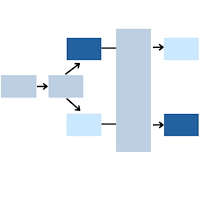Previous Posts
What statistical model would you use for longitudinal data to analyze between-subject differences with within-subject change? Most analysts would respond, “a mixed model,” but have you ever heard of latent growth curves? How about latent trajectories, latent curves, growth curves, or time paths, which are other names for the same approach?
Generalized linear models—and generalized linear mixed models—are called generalized linear because they connect a model’s outcome to its predictors in a linear way. The function used to make this connection is called a link function. Link functions sounds like an exotic term, but they’re actually much simpler than they sound.
Like any applied skill, mastering statistical analysis requires: 1. building a body of knowledge 2. adeptness of the tools of the trade (aka software package) 3. practice applying the knowledge and using the tools in a realistic, meaningful context.
In fixed-effects models (e.g., regression, ANOVA, generalized linear models), there is only one source of random variability. This source of variance is the random sample we take to measure our variables. It may be patients in a health facility, for whom we take various measures of their medical history to estimate their probability of recovery. Or random variability may come from individual students in a school system, and we use demographic information to predict their grade point averages.
If you are new to using generalized linear mixed effects models, or if you have heard of them but never used them, you might be wondering about the purpose of a GLMM. Mixed effects models are useful when we have data with more than one source of random variability. For example, an outcome may be measured more than once on the same person (repeated measures taken over time). When we do that we have to account for both within-person and across-person variability. A single measure of residual variance can’t account for both.
In this webinar, we will provide an overview of generalized linear models. You may already be using them (perhaps without knowing it!). For example, logistic regression is a type of generalized linear model that many people are already familiar with. Alternatively, maybe you’re not using them yet and you are just beginning to understand when they might be useful to you.
The Cox regression model has a fairly minimal set of assumptions, but how do you check those assumptions and what happens if those assumptions are not satisfied?
Parametric models for survival data don’t work well with the normal distribution. The distributions that work well for survival data include the exponential, Weibull, gamma, and lognormal distributions among others. These distributions give you a broad range of hazard functions...
Survival analysis isn't just a single model. It's a whole set of tests, graphs, and models that are all used in slightly different data and study design situations. Choosing the most appropriate model can be challenging. In this article I will describe the most common types of tests and models in survival analysis, how they differ, and some challenges to learning them.
In this webinar you will learn what these variables are, introduce the relationships between the Poisson, Bernoulli, Binomial, and Normal distributions, and see an example of how to actually set up the data and specify and interpret the logistic model for these kinds of variables.



 stat skill-building compass
stat skill-building compass